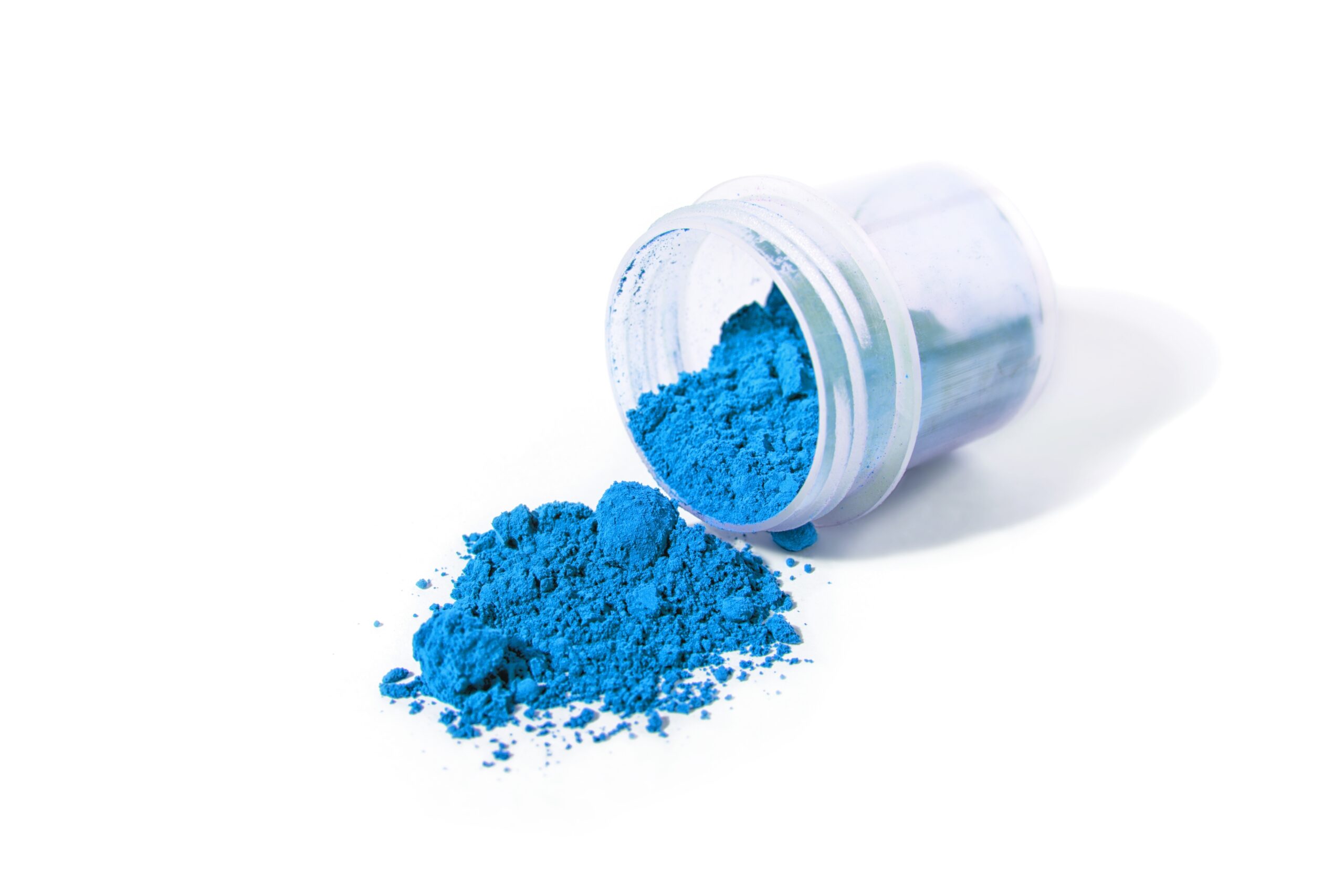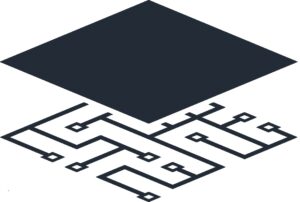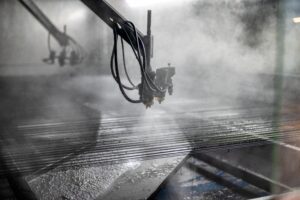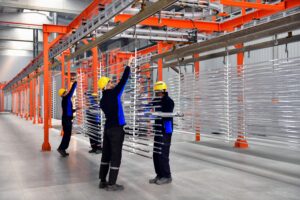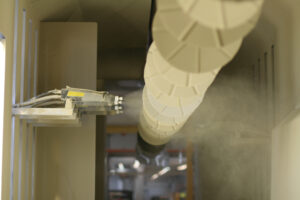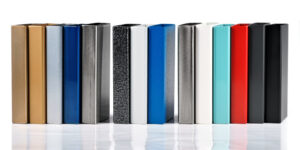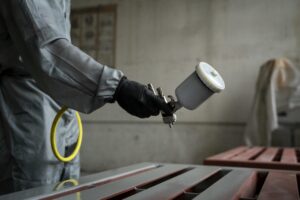Choosing the optimal powder coating for your project is more than picking a color off the shelf. The wrong powder chemistry or finish can lead to premature wear, corrosion, color fade, or excessive maintenance costs. Whether you’re coating steel fencing, aluminum extrusions, or consumer appliances, understanding how substrate, environment, finish requirements, and long-term color stability interact will guide you to the best-performing system.
In this guide, we’ll walk through each critical factor and offer practical tips for specifying the ideal powder coating for any application.
1. Substrate Material Compatibility
Different substrates demand different chemistries. Matching resin type and pretreatment to your base material ensures strong adhesion, corrosion resistance, and a uniform appearance.
Steel and Iron
- Recommended Chemistries: Epoxy-based powders provide excellent adhesion and corrosion protection in mild environments but can chalk under UV. Polyester-epoxy hybrids balance corrosion resistance with some UV stability.
- Pretreatment: Phosphate or iron-phosphate conversion coatings enhance mechanical anchoring of the powder. Chromate-free processes can be used to meet environmental regulations.
Aluminum and Galvanized Steel
- Recommended Chemistries: Polyester TGIC (triglycidyl isocyanurate) powders excel outdoors, offering strong UV resistance and flexibility to handle thermal expansion.
- Pretreatment: Zirconium or zirconium-based conversion coatings avoid white rust issues common with zinc substrates.
Zinc, Brass, and Copper
- Specialty primers or conductive powders may be required. Consult your powder supplier for dedicated systems that bond to non-ferrous metals.
Non-Metals (Wood, MDF, Certain Plastics)
- Thermoset powders aren’t typically recommended on bare plastics or wood—unless specifically formulated. Consider liquid coatings or hybrid powders with adhesion promoters.
Key Takeaway: Always verify with your powder manufacturer that the chosen chemistry and pretreatment are qualified for your specific substrate.
2. Environmental Exposure: Indoor vs. Outdoor
The service environment dictates which powder properties are mission-critical.
| Environment | Key Concerns | Recommended Powder Types |
| Indoor | Chemical resistance, impact | Epoxy, epoxy-hybrids |
| Outdoor | UV stability, corrosion | Polyester TGIC, TGIC-free polyester, fluoropolymer powders |
- Indoor Applications
- Epoxy powders provide excellent chemical and abrasion resistance for appliances, furniture, and machine enclosures. They are cost-effective and cure at moderate temperatures.
- Outdoor Applications
- Polyesters with TGIC or TGIC-free curing agents deliver superior color retention and chalk resistance in direct sunlight.
- For extreme environments (marine, industrial), consider fluoropolymer (PVDF or FEVE) powders for unmatched UV and chemical durability.
Tip: When in doubt, specify a polyester over an epoxy for any outdoor-exposed part.
3. Desired Finish and Aesthetics
The visual and tactile qualities of your coating are equally important to performance.
- Gloss Level: Ranges from matte (10–30 GU) to high gloss (80–95 GU). High-gloss finishes highlight surface imperfections, while matte hides flaws but may show fingerprints.
- Texture: Fine textures conceal minor substrate defects and reduce glare. Hammertone, wrinkled, or sand textures can add functional grip or hide weld seams.
- Metallics and Pearlescents: Require specialized dispersion and clear-coat compatibility. These powders often cost 15–30 % more and need precise batch control.
Selection Advice:
- Obtain physical finish samples or flake cards rather than relying on digital swatches.
- Confirm minimum film thickness (typically 60–80 µm) and critical gloss range with your supplier.
- Ensure finish choice aligns with the end-use—for example, consumer electronics often mandate ultra-smooth, high-gloss exteriors, whereas industrial equipment benefits from tougher epoxy-hybrid textures.
4. Color Retention and Fade Resistance
Long-term aesthetics hinge on UV stability and pigment quality.
- Pigment Types: Organic pigments (azo, phthalocyanine) deliver vibrant colors but can fade faster under sunlight. Inorganic pigments (iron oxides, titanium dioxide) offer superior fade resistance.
- UV Absorbers and HALS: Many outdoor powders include UV-absorbing additives and Hindered Amine Light Stabilizers to prevent resin breakdown and yellowing.
- Chalk Resistance: Prevents powder degradation into a chalky residue when exposed to sun and rain—critical for bright, saturated colors.
Best Practices:
- For bright reds, oranges, and yellows, insist on QUV-B accelerated weather testing data for at least 1,500 hours to validate colorfastness.
- Choose powders with at least a 3-year warranty on exterior fade (check ASTM D523 gloss retention metrics).
5. Curing Parameters and Production Constraints
Your curing oven capacity and line speed can limit powder choices.
- Cure Temperature: Most powders cure between 160 °C and 200 °C. Epoxy powders often cure at 180 °C for 10 min, while polyesters can cure at 180 °C–200 °C for 10–15 min.
- Throughput Requirements: Faster line speeds may require powders that cure at lower temperatures or shorter times—e.g., some TGIC-free polyesters cure in 6 min at 180 °C.
- Part Thickness & Geometry: Heavy or complex parts may require extended cure times. Insufficient cure leads to poor crosslink density and compromised performance.
Production Tip: Work with your powder supplier to run a trial cure matrix—varying time and temperature—to find the “sweet spot” that meets both throughput and performance criteria.
6. Regulatory and Sustainability Considerations
Compliance and green credentials are increasingly important.
- VOC and HAPs: Powder coatings are generally zero-VOC and low-HAP, but always verify regulatory declarations, especially if exporting to regions with stringent REACH or EPA standards.
- Recyclability: Ensure overspray recovery systems are in place. Modern powders can be reclaimed at up to 95 % efficiency.
- Certifications: Some industries demand ISO 12944 (marine) or GSB standards for decorative coatings—confirm that your chosen powder line holds the necessary approvals.
7. Testing, Sampling, and Final Specification
Before full-scale production, validate performance with these steps:
- Sample Panels: Spray and cure panels under your exact shop conditions, then inspect for color, gloss, adhesion (ASTM D3359), and impact resistance (ASTM D2794).
- Salt Spray Testing: For corrosion-sensitive applications, perform ASTM B117 salt spray tests for 500 – 1,000 hours.
- Warranty & Technical Data Sheets: Review cure schedules, adhesion data, chemical resistance profiles, and chalk/fade test results to confirm performance claims.
Conclusion and Next Steps
Selecting the right powder coating requires a balance of substrate compatibility, environmental durability, aesthetic finish, colorfastness, and production practicality. By working closely with your powder supplier, conducting real-world trials, and verifying performance data, you’ll ensure a coating system that not only looks great today but stands up to the rigors of tomorrow.
Ready to streamline your powder coating processes and ensure powder savings?
Schedule a free demo to see how coatingAI’s Blueprint™ OS can ensure a minimum of 10% reduction in powder usage!

